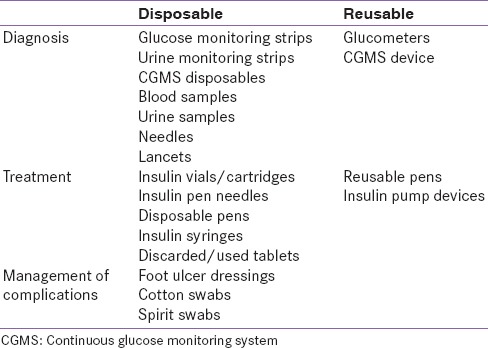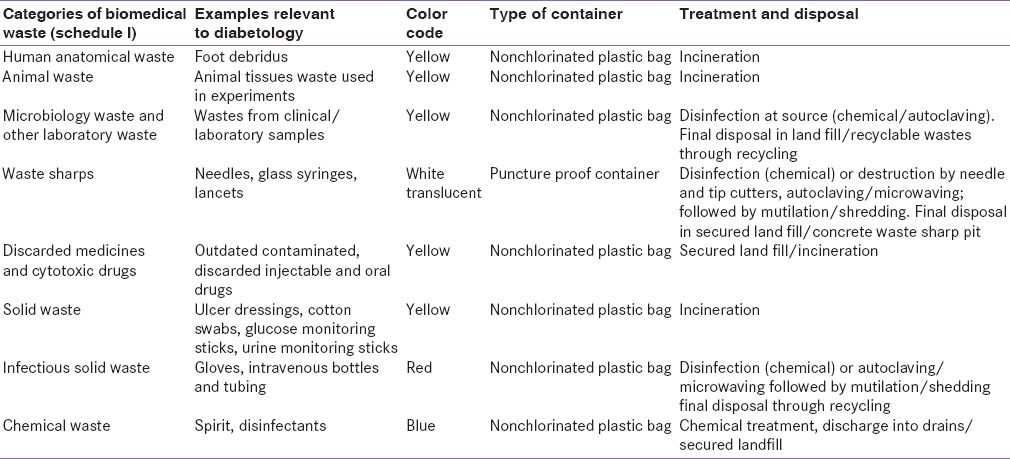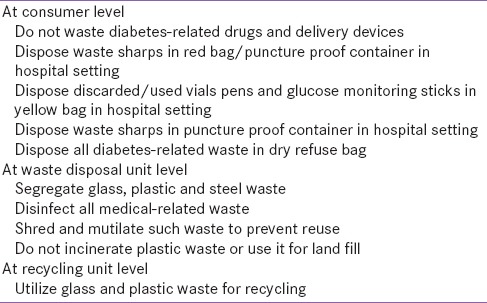This editorial aims to highlight the various rules and regulations of waste disposal and explain them a propos diabetes waste. It hopes to encourage a nation-wide movement for green diabetology, which utilizes scientific practices to prevent an adverse impact of diabetes waste on our environment. The communication also tries to sensitize diabetes care professionals to their responsibility toward the physical environment, while reinforcing the need for interdisciplinary cooperation between all stakeholders.
Diabetes has become pan-endemic now.[1] Apart from the health-related and economic consequence of uncontrolled glycemia, avoidable chronic complications, and acute co-morbid conditions, there is another issue that has hitherto been ignored. This is the burden that modern diabetes management places upon the environment. While modern insulin technique guidelines address the need for appropriate disposal of needles and syringes,[2,3] this aspect is not discussed in conjunction with national regulations for biomedical waste disposal. Thus, the potential impact of diabetes care upon our surroundings is not realized.
ENVIRONMENTAL BURDEN
The 65 million Indians living with diabetes consume about 160 million insulin syringes and about 50 million pen needles annually, along with about 40 million syringes used for immunization (source: IMS data and market assumption on insulin injection habits). Each syringe weighs 3.28 g. Excluding the weight of the cannula, the net amount of plastic generated from insulin syringes alone, each year is 600,000 kg (3 g × 200 million syringes) (derived from IMS data).
Apart from this, roughly 9.6 crore (96,000,000) vials, cartridges and prefills are consumed in a 12-month period (6.7 crore vials, 2.5 cartridge and 0.7 disposable pens), adding to the burden of glass and plastic on the environment (derived from IMS data).
As the number of people living with diabetes increase, diabetes care-related waste is bound to rise, as modern tools and devices are used more frequently for diabetes management. Table 1 lists some commonly produced diabetes waste, which can be classified into bio-medical, plastic, and e-waste. Table 2 enumerates the various categories of bio-medical waste, as listed in current Indian regulations.
Table 1.
Bio-medical waste produced in diabetology

Table 2.
Bio-medical waste disposal

BIO-MEDICAL WASTE
“Bio-medical waste” means any waste, which is generated during the diagnosis, treatment or immunization of human beings or animals, or in research activities pertaining there to or in the production or testing of biologicals.[4]
As per current Indian regulations, medical products used and discarded in a hospital setting are considered biomedical waste. However, those used in the home care or domestic setting, including insulin syringes, needles, lancets, cartridge and pens, are included in municipal solid waste (MSW), and disposed accordingly.[4]
Untreated bio-medical waste should not be mixed with other waste. It should be segregated into color-coded, labeled containers/bags at the point of generation, prior to storage, transportation, treatment and disposal. Bags of appropriate color with nonwashable labels must be used.
According to earlier guidelines, glucose monitoring sticks, and other solid waste were to be collected in red bags. Now, they can be disposed of in yellow nonchlorinated bags.
Disposable pens should be disposed of after removing pen needles. Pen needles should also be disposed of safely. Transport should be undertaken only in authorized vehicles.
Storage of bio-medical waste of categories 1, 2, 3, and 6 should not exceed 48 h without treatment. This includes items contaminated with blood and body fluids, including monitoring sticks, cotton swabs, ulcer dressings, (category 6) and waste from clinical/laboratory samples (category 3).[4]
PLASTIC WASTE
Plastic waste is a separate type of special waste. Various plastics used in manufacture are classified into seven types by the Bureau of Indian Standards. These include both recyclable and nonrecyclable varieties.
Plastic is an important waste generated by diabetology. Plastic syringes, disposable pens, reusable pens, pen needles, glucometers, and other monitoring devices are all made of plastic. Medicine bottles and insulin syringes are made of polypropylene (PP). Disposable pens are also made of PP. Most disposable pens contain a cartridge made of type 1 (flint) glass, a plunger of bromobutyl, a stopper of bromobutyl/polyisoprene, and a glass ball to facilitate resuspension. Dimeticone or silicon emulsion may have been used to treat the cartridge plunger, and/or the glass cartridge.[5,6]
RE-CYCLING
According to Indian MSW (Management and Handling) Rules, 2000, treated biomedical wastes that are subjected to disinfection or autoclaving are considered to be devoid of any biological or microbiological organisms. They can, in effect, be disposed of as MSW.
The bulk of plastic used in diabetes care, therefore, can easily be shifted from bio-medical waste to plastic waste, provided it is disinfected properly. This will include all insulin syringes, plastic cartridges and pens. The plastic used in the manufacture of many disposable pens is biodegradable. However, the time frame for bio-degradation is quite long. Hence, disinfection, followed by recycling, is a better option. The same applies for glass waste, such as vials and cartridges, and stainless steel waste, like needles. These can also be disinfected and recycled as per norms of MSW disposal.
Such a practice will allow recycling, promote conservation and efficiency, and help in revenue generation for waste disposal sites. Strict safeguards to prevent the spread of infections among waste handlers and end-users must be put in place. It must be re-emphasized that recycling; which is an acceptable approach to plastic disposal, is completely different from re use, which is absolutely contraindicated. The Schedule I specifically mentions that “shredding and mutilation must be such that so as to prevent unauthorized reuse.” Cutting the needle hub allows separation of most, but not all, of the stainless steel component from the plastic component of syringes.
Plastic waste can be recycled, used for co-processing in cement plants, or blended with bitumen and used to construct roads. All these conventional technologies are more reliable than an unproven method such as plasma pyrolysis and liquid fuel generation. Incineration and land filling of plastic should be avoided.
SUMMARY
Diabetes care professionals have a responsibility not only towards persons with diabetes, but also towards the community at large, and the environment. Modern diabetes care understands its social obligations and works to involve society, community and family in the management of the syndrome.
Our attitude toward the physical environment, however, is not so laudable. We exhibit a person-centric approach toward our environment, advocating for diabetes – friendly surroundings.[7] While we decry the role of chemical pollutants and physical obstacles in promoting disease, we neglect our own contribution to pollution of our environment. This responsibility has to be shared by all stake-holders from consumer to waste disposer to recycler [Table 3]. However, as health care professionals, it is our duty and responsibility to ensure that safe disposal takes place.[8,9]
Table 3.
Recommendations for optimal disposal of diabetes-related waste

GREEN DIABETOLOGY
Through this editorial, we support the call for a green diabetology movement,[9] which addresses safe and environment-friendly insulin disposal. We encourage adoption of simple practices that will facilitate optimal recycling and usage of insulin-related waste material while providing a source for revenue generation as well.
REFERENCES
- 1.Kalra S, Kumar A, Jarhyan P, Unnikrishnan AG. Endemic or epidemic. Measuring the endemicity index of diabetes? Indian J Endocrinol Metab. 2015;19:5–7. doi: 10.4103/2230-8210.144633. [DOI] [PMC free article] [PubMed] [Google Scholar]
- 2.Kalra S, Balhara YP, Baruah MP, Chadha M, Chandalia HB, Chowdhury S, et al. Forum for injection techniques, India: The first Indian recommendations for best practice in insulin injection technique. Indian J Endocrinol Metab. 2012;16:876–85. doi: 10.4103/2230-8210.102929. [DOI] [PMC free article] [PubMed] [Google Scholar]
- 3.Tandon N, Kalra S, Balhara YP, Baruah MP, Chadha M, Chandalia HB, et al. Forum for injection technique (FIT), India: The Indian recommendations 2.0, for best practice in insulin injection technique, 2015. Indian J Endocrinol Metab. 2015;19:317–31. doi: 10.4103/2230-8210.152762. [DOI] [PMC free article] [PubMed] [Google Scholar]
- 4.Draft Bio-Medical Waste. (Management and Handling) Rules, 2015. Ministry of Environment, Forest and Climate Change. [Last accessed on 2015 Aug 31]. Available from: http://www.moef.nic.in/sites/default/files/Final_vetted_BMW%20Rules%202015.pdf .
- 5.Novo Mix 50(R) [Summary of Product Characteristics] India: Novo Nordisk India Pvt Ltd; 2015. [Google Scholar]
- 6.Humalog Mix 25 [Summary of Product Characteristics] India: Eli Lilly India Pvt Ltd; 2015. [Google Scholar]
- 7.Kumar KM, Raghupathy P, Kalra S. Diabetes-friendly environments for children with diabetes. Indian J Endocrinol Metab. 2015;19(Suppl 1):S1–3. doi: 10.4103/2230-8210.155324. [DOI] [PMC free article] [PubMed] [Google Scholar]
- 8.Mahtab H, Pathan MF, Ahmed T, Bajaj S, Sahay R, Raza SA, et al. The Dhaka declaration 2015. Indian J Endocrinol Metab. 2015;19:441–2. doi: 10.4103/2230-8210.159014. [DOI] [PMC free article] [PubMed] [Google Scholar]
- 9.Majumdar A, Sahoo J, Roy G, Kamalanathan S. Improper sharp disposal practices among diabetes patients in home care settings: Need for concern? Indian J Endocrinol Metab. 2015;19:420–5. doi: 10.4103/2230-8210.152792. [DOI] [PMC free article] [PubMed] [Google Scholar]


